The SECURE 2.0 Act of 2022 (SECURE 2.0) significantly changes the legal and administrative compliance landscape for U.S. retirement plans. Foley & Lardner LLP is authoring a series of articles that take a “deep dive” into key SECURE 2.0 provisions that will affect how employers structure and administer their 401(k) plans, pension plans, and other types of employer-sponsored retirement plans.
In the last two installations, we discussed SECURE 2.0’s new required minimum distribution rules and changes designed to simplify plan administration. In this article, we explore the new student loan matching contribution opportunity for defined contribution plans, including 401(k) plans.
Currently, employers may only make matching contributions to a defined contribution plan based on an eligible employee’s contributions to their defined contribution retirement plan accounts. Unfortunately, some employees with student loan debt may not feel comfortable contributing to their retirement plan, especially early in their careers, because they need to use their current compensation to pay down their student loans. This dynamic may result in many employees missing out on employer matching contributions and losing significant value in their long-term retirement savings.
To help address this issue, some employers previously adopted innovative programs that provide additional non-elective contributions if eligible employees make qualifying loan repayments. However, because these programs do not involve real matching contributions and must be designed carefully to avoid violation of the contingent benefit rule under Internal Revenue Code (“Code”) Section 401(k)(4)(A), these non-elective contribution programs can be complicated to design, administer, and communicate. These programs also carry slightly more regulatory risk than a program that complies with statutory requirements because they are based on guidance provided in a 2018 Internal Revenue Service Private Letter Ruling (PLR) and PLRs may only be relied upon by the taxpayer to which they are issued.
Under a much-anticipated provision of SECURE 2.0, starting in 2024, employers may also make matching contributions to retirement plans governed by Code Section 401(k), 403(b), 457(b) government plans, and SIMPLE-IRA plans based on the employee’s qualified student loan payments. In order to receive this new type of matching contribution, eligible employees must simply certify that eligible loan payments have been made on an annual basis—the plan sponsor is not required to conduct an independent review.
From a design perspective, the eligibility criteria, matching contribution rate, and vesting schedule applicable to student loan matching contributions must be the same as those that apply to the plan’s regular matching contributions, but the employer may deposit the matching contributions to the employee’s 401(k) plan account less frequently than regular matching contributions, as long as they are contributed at least annually. SECURE 2.0 also provides some limited relief for actual deferral percentage (ADP) testing and application of the Code Section 415 limit on annual additions. This will likely allow employers to integrate these new programs into their existing matching programs more easily than a new non-elective contribution and without having to worry about structuring the program to avoid violation of the (sometimes confusing) contingent benefit rule.
While this new rule is a welcome expansion of the existing matching contribution rules under the Code, some questions remain, including:
-
What types of loans will qualify—loans for the employee’s education only or any student loan in the employee’s name for which they are or could become financially responsible (e.g., parent plus loans)?
-
SECURE 2.0 provides that a student loan matching contribution program must be made available to all employees who are eligible for regular matching contributions. Will plan sponsors be permitted to make exceptions for collectively bargained employees and/or highly compensated employees?
-
May plan sponsors use narrower definitions of qualified student loan payments?
-
Will plan sponsors be permitted to impose more stringent documentation requirements on employees?
-
Is there overlap with Federal student loan forgiveness that makes this type of program less attractive?
Plan sponsors are hopeful that the Internal Revenue Service will provide answers to these questions and other similar issues when the regulations are issued, which is expected to be later this year.




 />i
/>i

